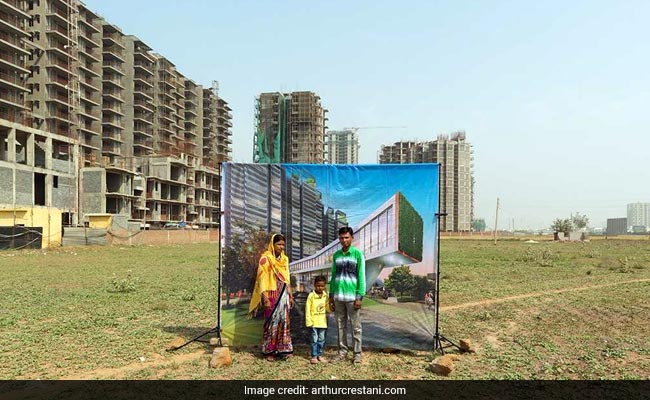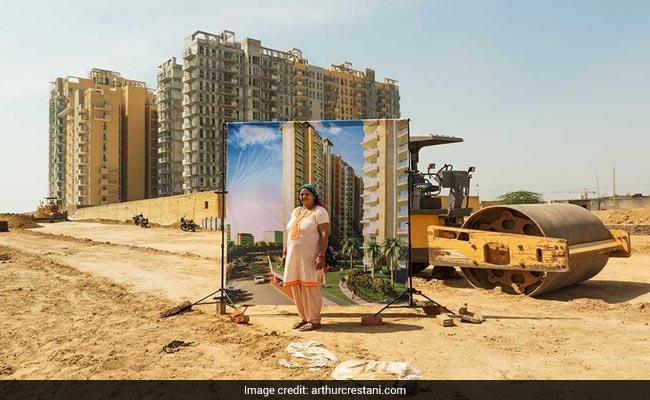
Bangkok:
A photographic exhibition in Paris aims to capture both the rapid growth of Gurgaon and the deep divide in India's urban centres, where workers aspire to live in the gleaming properties they build or clean.
"Bad City Dreams" features about 20 photographs of Gurgaon, 30 kilometres southwest of New Delhi, by Paris-based Arthur Crestani.
The pictures show construction workers, villagers and vendors posing against large, glossy advertisements for luxury developments, with construction sites looming behind them.
"I wanted to show how the real estate market is shaping dreams and desires, the idea of home and city, which is in total contrast to the reality of Indian cities," said Mr Crestani, who first went to Delhi as an exchange student in 2010.
"The language and visuals of the ads are so exuberant - all lush settings and serene lives. But they are fantasised versions that are not representative of the reality, and do not include the workers and the villagers," he said.
 Rapid urbanisation and rising incomes in India have led to a sprawl of office towers and luxury apartments. Gurgaon, although a global technology hub, is notorious for its daily traffic jams and its water-logged roads during the rains.
Rapid urbanisation and rising incomes in India have led to a sprawl of office towers and luxury apartments. Gurgaon, although a global technology hub, is notorious for its daily traffic jams and its water-logged roads during the rains.
"Cities want to be seen as modern, global and smart, but (they) cover up real problems like pollution and the lack of planning and infrastructure," said Mr Crestani, 27, whose photographs are being exhibited in a Paris show until May 6.
"Slums are demolished for so-called beautification, and the people who work in the gated communities live in shacks and (are) seen as dirty encroachers," he told the Thomson Reuters Foundation by phone.
 Last year, violent protests erupted at a gated community near Delhi after a domestic worker filed a police complaint saying her employers had beaten her and locked her up.
Last year, violent protests erupted at a gated community near Delhi after a domestic worker filed a police complaint saying her employers had beaten her and locked her up.
But Mr Crestani said the people he photographed seemed to accept their place in society.
"There was some sadness about not being a part of the world in the ads. But there was also hope for a better future for their children," he said. "They also really liked those buildings in the ads."
(Reporting by Rina Chandran, Thomson Reuters Foundation)
"Bad City Dreams" features about 20 photographs of Gurgaon, 30 kilometres southwest of New Delhi, by Paris-based Arthur Crestani.
The pictures show construction workers, villagers and vendors posing against large, glossy advertisements for luxury developments, with construction sites looming behind them.
"I wanted to show how the real estate market is shaping dreams and desires, the idea of home and city, which is in total contrast to the reality of Indian cities," said Mr Crestani, who first went to Delhi as an exchange student in 2010.
"The language and visuals of the ads are so exuberant - all lush settings and serene lives. But they are fantasised versions that are not representative of the reality, and do not include the workers and the villagers," he said.

Paris-based Arthur Crestani said the people he photographed seemed to accept their place in society.
"Cities want to be seen as modern, global and smart, but (they) cover up real problems like pollution and the lack of planning and infrastructure," said Mr Crestani, 27, whose photographs are being exhibited in a Paris show until May 6.
"Slums are demolished for so-called beautification, and the people who work in the gated communities live in shacks and (are) seen as dirty encroachers," he told the Thomson Reuters Foundation by phone.

Arthur Crestani first went to Delhi as an exchange student in 2010, before the took up the "Bad City Dreams" project.
But Mr Crestani said the people he photographed seemed to accept their place in society.
"There was some sadness about not being a part of the world in the ads. But there was also hope for a better future for their children," he said. "They also really liked those buildings in the ads."
(Reporting by Rina Chandran, Thomson Reuters Foundation)
© Thomson Reuters 2018
Track Latest News Live on NDTV.com and get news updates from India and around the world

